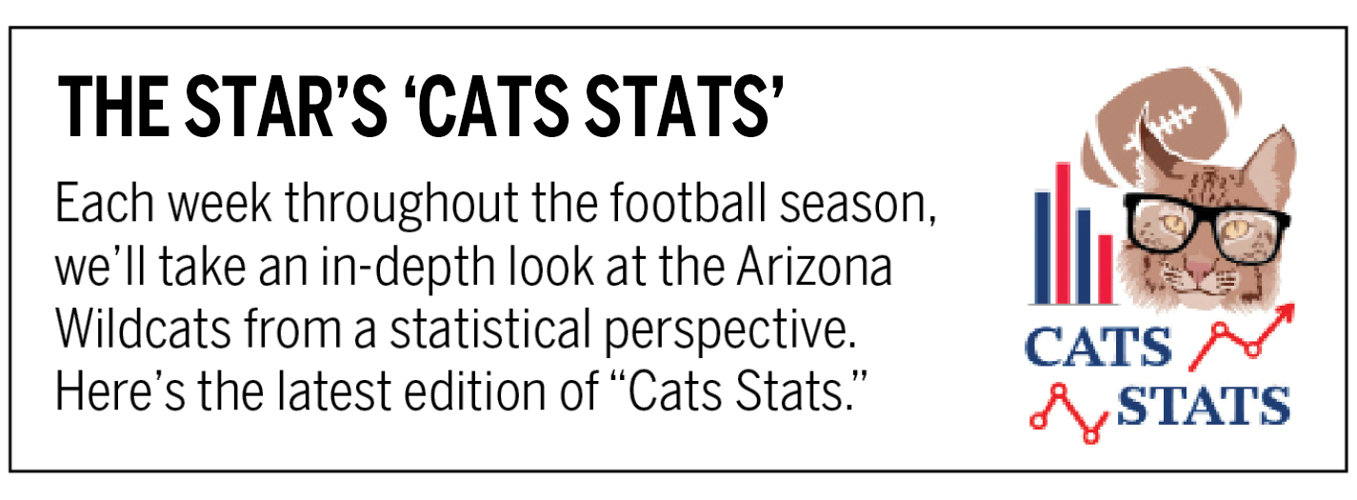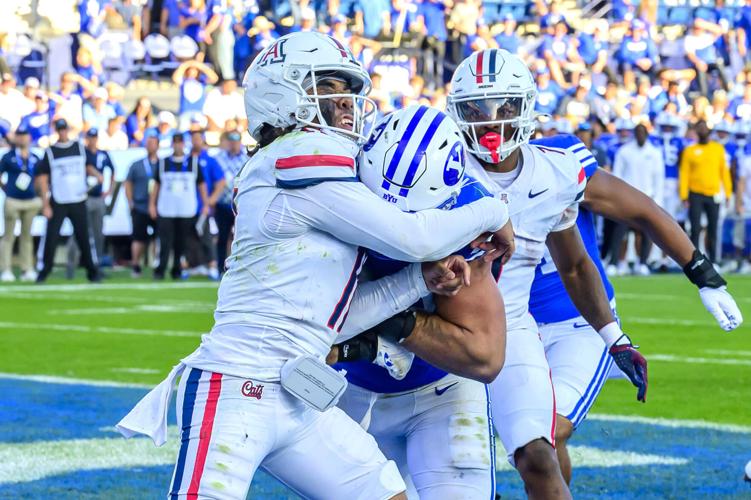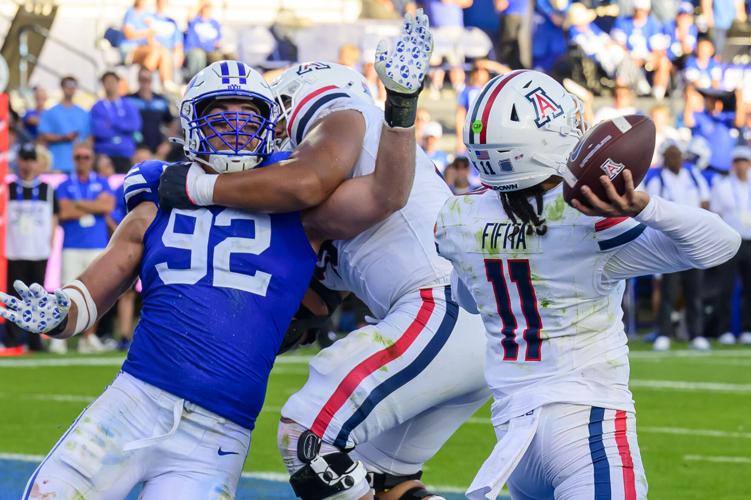Arizona’s offense hasn’t been right since early September.
One of the biggest causes: The offensive line hasn’t been right either.
That critical unit has been shuffling and scuffling all year long. Recently, pass protection has become so problematic that the offense can barely function.

Unlike quarterbacks, running backs and receivers, offensive linemen don’t accumulate volumes of individual statistics that we can break down every which way. But we dig deep here at “Cats Stats.” What follows are some numbers that help explain why the UA offensive line has struggled so much — and how the coaching staff might be able to aid the group heading into Saturday’s matchup against West Virginia.
Too many combos on menu
Last year, when Arizona went 10-3 and had one of the most efficient offenses in the Pac-12, the Wildcats used five offensive line combinations in 13 games.
They have used four in seven games this season because of injuries — and very likely will debut a fifth vs. the Mountaineers.

Arizona offensive lineman Jonah Savaiinaea (71) blocks BYU defensive end Blake Mangelson at the line of scrimmage during the Wildcats' 41-19 loss to the host Cougars on Oct. 12 in Provo, Utah.
Starting left tackle Rhino Tapa’atoutai is out for the season. Transfer Michael Wooten could make his first career start. Another transfer, Joey Capra, might be in the mix as well.
Either way, starting right tackle Jonah Savaiinaea is likely headed to the left side, where he has subbed in two games this season and started once (NAU). Savaiinaea also played multiple positions last year, but his secondary spot was right guard, where he started as a true freshman. Left tackle was foreign territory for Savaiinaea, at least in college, until he had to move there midgame vs. New Mexico in Week 1.
In 2023, three UA linemen started at the same position in all 12-regular season games: Jordan Morgan (left tackle), Wendell Moe Jr. (left guard) and Josh Baker (center). Moe and Baker have each missed a start this season. Morgan is playing for the Green Bay Packers. Arizona’s O-line hasn’t been the same since he left.
Pressure points
Only once last season did a UA opponent generate a pressure rate of greater than 40% — Oklahoma in the Alamo Bowl. Morgan opted out of that game to prepare for the NFL Draft. The reconfigured line surrendered pressure on 20 of 45 dropbacks (44.4%), according to Pro Football Focus.

Colorado defensive end Keaten Wade (27) and defensive lineman Shane Cokes (99) swarm over Arizona quarterback Noah Fifita and register a sack in the fourth quarter of their Big 12 matchup on Oct. 19 in Tucson.
Three opponents have exceeded 40% already this season — Colorado (47.2%), BYU (41.4%) and Utah (51.5%).
Overall, Noah Fifita has faced pressure on 36.8% of his dropbacks — nine percentage points higher than last season. It’s not because opponents are blitzing him more either; they’ve blitzed Fifita 42.4% of the time this year vs. 43.5% last year, per PFF. That suggests opposing defenses are getting home far more often with four or fewer rushers.
Pressure has affected Fifita much more this season than last. He has completed only 40.2% of his passes with a 2-5 touchdown-to-interception ratio when pressured, per PFF. Last season those numbers were 55.7% and 7-2.
Whether it’s Fifita, the line or both, the Wildcats aren’t recognizing and reacting to pressure the same way as last year. Fifita’s average time to throw when pressured last season was 3.39 seconds, per PFF. This season it’s 4.16 seconds.
Fifita is holding onto the ball too long — the last thing you want to do behind a struggling line.

Arizona quarterback Noah Fifita, left, is hit by BYU defensive end Tyler Batty, front right, during their Oct. 12 matchup in Provo, Utah.
Giving on the edge
Most of the pressure Arizona has allowed this season has come off the edges. PFF charged Tapa’atoutai — a redshirt freshman who didn’t play a down last season — with 15 pressures allowed in his six appearances. Savaiinaea has been tagged with 10 pressures allowed. Wooten yielded three in 16 pass-blocking snaps vs. Colorado last week.
One way to help the tackles is to keep a tight end in to block, or at least chip, an edge rusher. But that’s happened considerably less in the Dino Babers/Matt Adkins offense than it did in Jedd Fisch’s offense.
PFF data shows that tight ends blocked on 21.3% of passing snaps last season. This year that figure is just 7.5%.
Meanwhile, running backs are being asked to block more. They’ve stayed in to block on 35.3% of passing snaps compared to 21.8% last season.
These figures illustrate some of the structural differences between the previous scheme and this one. Arizona has made some adjustments over the course of the season, including changing play-callers, but hasn’t figured out a way to mitigate pass-rush pressure.

BYU defensive end Tyler Batty, left, attempts to sack Arizona quarterback Noah Fifita, right, during their game on Oct. 12 in Provo, Utah.
West Virginia has one of the most powerful edge rushers in the Big 12 in senior TJ Jackson. The transfer from Troy is tied with Arizona’s Tre Smith and two others for the league lead with 26 pressures.
The runaround
Some data suggests that Arizona’s offensive line is actually better at run blocking than last year’s unit. Other data suggests the Wildcats don’t run nearly enough.
Taking sacks out of the equation, the 2024 Cats average 5.65 yards per carry. The ’23 Cats averaged 5.34.
Using PFF’s yards-after-contact stat, one can extrapolate how many yards ball-carriers are gaining before contact. Last year, UA running backs gained 1.54 yards before contact. This year, they’re gaining 1.93 yards.
Arizona averages 5.40 yards per rushing attempt on first down, according to CFBStats.com. That figure ranks 30th nationally — just ahead of Notre Dame, Georgia and Wisconsin, among others.
Despite those numbers, the Wildcats have the second-fewest rushing attempts in the Big 12. Playing from behind a lot certainly factors into that. But it doesn’t explain how only six teams in the nation have fewer first-half rushing attempts than Arizona.
A greater commitment to the run game would alleviate pressure on Fifita and the offensive line. The UA staff has yet to show it’s willing to make that commitment.








